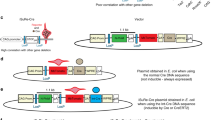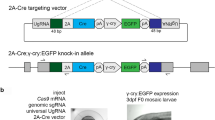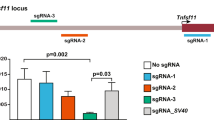Abstract
Studies of mammalian gene function are hampered by temporal limitations in which phenotypes occurring at one stage of development interfere with analysis at later stages. Moreover, phenotypes resulting from altered gene activity include both direct and indirect effects that may be difficult to distinguish. In the present study, recombinant fusion proteins bearing the 12 amino acid membrane translocation sequence (MTS) from the Kaposi fibroblast growth factor (FGF-4) were used to transduce enzymatically active Cre proteins directly into mammalian cells. High levels of recombination were observed in a variety of cultured cell types and in all tissues examined in mice following intraperitoneal administration. This represents the first use of protein transduction to induce the enzymatic conversion of a substrate in living cells and animals and provides a rapid and efficient means to manipulate mammalian gene structure and function.
This is a preview of subscription content, access via your institution
Access options
Subscribe to this journal
Receive 12 print issues and online access
$209.00 per year
only $17.42 per issue
Buy this article
- Purchase on Springer Link
- Instant access to full article PDF
Prices may be subject to local taxes which are calculated during checkout






Similar content being viewed by others
References
Nagy, A. Cre recombinase: the universal reagent for genome tailoring. Genetics 26, 99–109 (2000).
Sauer, B. Inducible gene targeting in mice using the Cre/lox system. Methods 14, 381–392 (1998).
Gu, H., Marth, J.D., Orban, P.C., Mossmann, H. & Rajewsky, K. Deletion of a DNA polymerase beta gene segment in T cells using cell type-specific gene targeting. Science 265, 103–106 (1994).
Betz, U.A., Vosshenrich, C.A., Rajewsky, K. & Muller, W. Bypass of lethality with mosaic mice generated by Cre-loxP-mediated recombination. Curr. Biol. 6, 1307–1316 (1996).
Kuhn, R., Schwenk, F., Aguet, M. & Rajewsky, K. Inducible gene targeting in mice. Science 269, 1427–1429 (1995).
Zou, Y.R., Muller, W., Gu, H. & Rajewsky, K. Cre-loxP-mediated gene replacement: a mouse strain producing humanized antibodies. Curr. Biol. 4, 1099–1103 (1994).
Sauer, B. & Henderson, N. Targeted insertion of exogenous DNA into the eukaryotic genome by the Cre recombinase. New Biol. 2, 441–449 (1990).
Smith, A.J. et al. A site-directed chromosomal translocation induced in embryonic stem cells by Cre-loxP recombination. Nat. Genet. 9, 376–385 (1995).
Van Deursen, J., Fornerod, M., Van Rees, B. & Grosveld, G. Cre-mediated site-specific translocation between nonhomologous mouse chromosomes. Proc. Natl. Acad. Sci. USA 92, 7376–7380 (1995).
Justice, M.J., Zheng, B., Woychik, R.P. & Bradley, A. Using targeted large deletions and high-efficiency N-ethyl-N-nitrosourea mutagenesis for functional analyses of the mammalian genome. Methods 13, 423–436 (1997).
Zheng, B. et al. Engineering a mouse balancer chromosome. Nat. Genet. 22, 375–378 (1999).
Su, H., Wang, X. & Bradley, A. Nested chromosomal deletions induced with retroviral vectors in mice. Nat. Genet. 24, 92–95 (2000).
Lakso, M. et al. Targeted oncogene activation by site-specific recombination in transgenic mice. Proc. Natl. Acad. Sci. USA 89, 6232–6236 (1992).
Fiering, S., Kim, C.G., Epner, E.M. & Groudine, M. An “in–out” strategy using gene targeting and FLP recombinase for the functional dissection of complex DNA regulatory elements: analysis of the beta-globin locus control region. Proc. Natl. Acad. Sci. USA 90, 8469–8473 (1993).
Russ, A.P. et al. Identification of genes induced by factor deprivation in hematopoietic cells undergoing apoptosis using gene-trap mutagenesis and site-specific recombination. Proc. Natl. Acad. Sci. USA 93, 15279–15284 (1996).
Lin, Y.Z., Yao, S.Y., Veach, R.A., Torgerson, T.R. & Hawiger, J. Inhibition of nuclear translocation of transcription factor NF-kappa B by a synthetic peptide containing a cell membrane-permeable motif and nuclear localization sequence. J. Biol. Chem. 270, 14255–14258 (1995).
Soriano, P. Generalized lacZ expression with the ROSA26 Cre reporter strain. Nat. Genet. 21, 70–71 (1999).
Anton, M. & Graham, F.L. Site-specific recombination mediated by an adenovirus vector expressing the Cre recombinase protein: a molecular switch for control of gene expression. J. Virol. 69, 4600–4606 (1995).
Kanegae, Y. et al. Efficient gene activation in mammalian cells by using recombinant adenovirus expressing site-specific Cre recombinase. Nucleic Acids Res. 23, 3816–3821 (1995).
Rohlmann, A., Gotthardt, M., Willnow, T.E., Hammer, R.E. & Herz, J. Sustained somatic gene inactivation by viral transfer of Cre recombinase. Nat. Biotechnol. 14, 1562–1565 (1996).
Feil, R. et al. Ligand-activated site-specific recombination in mice. Proc. Natl. Acad. Sci. USA 93, 10887–10890 (1996).
Kellendonk, C. et al. Regulation of Cre recombinase activity by the synthetic steroid RU 486. Nucleic Acids Res. 24, 1404–1411 (1996).
Schwarze, S.R., Ho, A., Vocero-Akbani, A. & Dowdy, S.F. In vivo protein transduction: delivery of a biologically active protein into the mouse. Science 285, 1569–1572 (1999).
Yan Liu, X. et al. Peptide-directed suppression of a pro-inflammatory cytokine response. J. Biol. Chem. 275, 16774–16778 (2000).
Perez, F. et al. Antennapedia homeobox as a signal for the cellular internalization and nuclear addressing of a small exogenous peptide. J. Cell. Sci. 102, 717–722 (1992).
Hawiger, J. Noninvasive intracellular delivery of functional peptides and proteins. Curr. Opin. Chem. Biol. 3, 89–94 (1999).
Schwartz, J.J. & Zhang, S. Peptide-mediated cellular delivery. Curr. Opin. Mol. Ther. 2, 162–167. (2000).
Schwarze, S.R., Hruska, K.A. & Dowdy, S.F. Protein transduction: unrestricted delivery into all cells? Trends Cell Biol. 10, 290–295 (2000).
Rojas, M., Donahue, J.P., Tan, Z. & Lin, Y.Z. Genetic engineering of proteins with cell membrane permeability. Nat. Biotechnol. 16, 370–375 (1998).
Kolb, A.F. & Siddell, S.G. Genomic targeting with an MBP–Cre fusion protein. Gene 183, 53–60 (1996).
Morgenstern, J.P. & Land, H. Advanced mammalian gene transfer: high titre retroviral vectors with multiple drug selection markers and a complementary helper-free packaging cell line. Nucleic Acids Res. 18, 3587–3596 (1990).
Pear, W.S., Nolan, G.P., Scott, M.L. & Baltimore, D. Production of high-titer helper-free retroviruses by transient transfection. Proc. Natl. Acad. Sci. USA 90, 8392–8396 (1993).
Beddinton, R.S. & Lawson, K.A. In Postimplantation mammalian embryos. (eds Copp, A.J. & Cockroft, D.L.) 267–292 (IRL Press, New York, NY; 1990).
Acknowledgements
We thank Mark Magnuson and Yao Zhong Lin for providing S4R ES cells and pMTS2 plasmid, respectively, and Jacek Hawiger, Dean Ballard, and Gene Oltz for critical reading of this manuscript. This work was supported by a Public Health Service Grant (R01RR13166 to H.E.R.) and by a grant from the Kleberg Foundation. Additional support was provided by a Cancer Center Support grant (P30CA42014) to the Vanderbilt-Ingram Cancer Center.
Author information
Authors and Affiliations
Corresponding author
Rights and permissions
About this article
Cite this article
Jo, D., Nashabi, A., Doxsee, C. et al. Epigenetic regulation of gene structure and function with a cell-permeable Cre recombinase. Nat Biotechnol 19, 929–933 (2001). https://doi.org/10.1038/nbt1001-929
Received:
Accepted:
Issue Date:
DOI: https://doi.org/10.1038/nbt1001-929
This article is cited by
-
Efficient deletion of LoxP-flanked selectable marker genes from the genome of transgenic pigs by an engineered Cre recombinase
Transgenic Research (2020)
-
Virus-Like Particles Derived from HIV-1 for Delivery of Nuclear Proteins: Improvement of Production and Activity by Protein Engineering
Molecular Biotechnology (2017)
-
Preparation of cell-permeable Cre recombinase by expressed protein ligation
BMC Biotechnology (2015)
-
Observational fear learning involves affective pain system and Cav1.2 Ca2+ channels in ACC
Nature Neuroscience (2010)
-
Transcription factor-based modulation of neural stem cell differentiation using direct protein transduction
Cellular and Molecular Life Sciences (2010)



